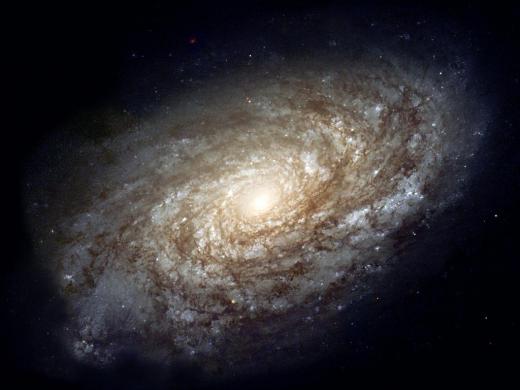What is Hubble's Law?
 Mary McMahon
Mary McMahon
Hubble's Law is a description of an observation made by Edwin Hubble in 1929. Hubble noted that objects in the universe appeared to be moving apart from each other, and that the further a galaxy was from an observer, the faster it would move. This observation is used as the basis for Hubble's Constant, an estimate of the galaxy's rate of expansion which is an important concept in cosmology, used to support a number of discussions about the nature of the universe. Hubble's Constant is actually better termed “Hubble's Variable,” because it is time dependent.
The observations made by Hubble were based on using spectroscopy to look at the redshift of galaxies he was observing. Redshift, the result of the Doppler Effect, which causes a wave to change frequency when the object emitting the wave moves relative to the observer, is a shift in the spectrum of light emitted by a galaxy towards the red end of the spectrum. Redshifting occurs when galaxies are moving away relative to the observer. Galaxies moving towards an observer undergo what is known as a blueshift, with light moving towards the blue end of the spectrum.

Hubble's observations led him to understand that galaxies were moving away from each other, and that, furthermore, the further away a galaxy was, the faster it was moving. This is the foundation of Hubble's Law, and an underpinning of the expanding universe theory. It is important to be aware of the fact that this phenomenon can be observed from anywhere in the universe. The universe, as it turns out, has a great deal in common with a poppyseed muffin: as the universe/muffin expands, the galaxies/poppyseeds inside move apart from each other.
Hubble's Law is sometimes expressed with this equation: V=H0D. The equation reflects the relationship between velocity, determined with the assistance of spectroscopy; Hubble's Constant, reflecting the rate of expansion occurring across the universe; and distance. Several different values for Hubble's Constant have been arrived at by cosmologists. The most accurate values are believed to have been determined with the assistance of the famous telescope named after Hubble. Hubble's Constant is believed as of 2009 to be about 74 kilometers per second for every megaparsec in distance.
Velocity and distance cannot be measured directly. This means that the data arrived at with the assistance of Hubble's Law could be erroneous. In fact, there have been brisk arguments ever since 1929 about Hubble's Law and its implications for the nature of the universe.
AS FEATURED ON:
AS FEATURED ON:











Discussion Comments
An important cosmological issue which Hubble's Law raises is that of the closed vs. open universe. In a closed universe, we are currently expanding, but will eventually implode in a reverse Big Bang. In an open universe, the Big Bang resulted in the current expansion, which will continue indefinitely until the universe loses all its heat and freezes completely in an expansion into nothingness.
@anon124755
Hubble's constant is believed to be a variable because it does increase over time. In the Accelerating Universe theory, the value determines the rate of acceleration in the expansion of the universe and this acceleration may itself increase over time. It is therefore unlikely that there is a set significant value in this acceleration variable, but "only time will tell."
does the Hubble's constant keep on increasing with a significant value?
Post your comments